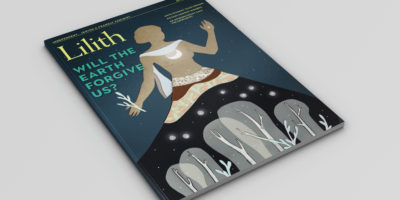
Esther in a New World
As part of his only recorded speech in the book of Esther, Mordechai exhorts Esther to appeal to King Ahasuerus, suggesting that Queen Esther’s raison d’être was to rise to the occasion and deliver the Jewish people from danger. And yet, as a new anthology of essays suggests, Queen Esther has served many purposes over time—her inspiration and her legacy have been both invoked and appropriated.
In Esther in America, edited by Rabbi Dr. Stuart W. Halpern [Maggid, $29.95], an array of scholars, rabbis and educators consider the roles that Esther—and the scroll in which she appears—have played throughout American history, making the case that this ancient Persian story of Jewish triumph over evil resonates with the American experience.
The popular and prolific Puritan minister Cotton Mather frequently cited Queen Esther as a model of independent action and fidelity to her husband in his Ornaments for the Daughters of Zion, a conduct and virtue manual. American abolitionist women, including Angelina Grimke, Harriet Beecher Stowe and Sojourner Truth, identified the plight of the Jews in Persia with the suffering of American slaves, casting Esther first in the role of the Black slave woman, valued for her sexual capital, and then in the role of the Southern Christian white woman, charged to speak out against injustice. In both contexts, Esther emerges as both obedient and independent.
Esther was an inspiration for American novelists as well. Tzvi Sinensky, one of the most cogent and compelling contributors to this anthology, argues that Hester Prynne, heroine of the American classic The Scarlet Letter, was modeled on the biblical Esther; both are beautiful, strong women compelled to join alien communities (Ahasuerus’ court, Puritan New England) and align themselves with older men (Ahasuerus, Reverend Dimmesdale) while concealing an important and fateful secret (Esther is a Jew! Dimmesdale is the father of Hester’s child!) that determines their outcome.
Beyond noting these parallels, Sinensky argues that the striking omission of any window into Esther’s inner life in the Biblical scroll is filled in by Hawthorne’s rich portrait of Hester’s subjective experience. Like Hester, perhaps Esther drew her resilience from her inner moral compass and resisted assimilating the values of the surrounding society. Sinensky’s essay points to a way of reading later works of secular (or at least non-Jewish) fiction as a midrash on sacred texts.
American Jews, too, looked to Esther for inspi- ration in their struggle to maintain tradition while finding a foothold in the broader culture. As Shaina Trapedo argues in an essay about Queen Esther beauty pageants, “unlike any other biblical narrative, the book of Esther offers a model of a people who … shape their own destiny based on merit, ingenuity, and self-reliance consistent with the American dream.” Indeed, American Jews continue to turn to the book of Esther to make sense of their experience, as evidenced by Dara Horn’s insightful essay comparing the situation of the Jews in ancient Persia and in early twentieth-century America; both believed—because they so desperately wanted to believe—that they would be accepted.
Drawing her evidence from immigration and legal records, Horn dispels the myth that the names of Jewish immigrants were changed at Ellis Island, demonstrating that it was rather the immi- grants themselves who changed their names so as to find acceptance and success in an America in which a Rosenberg would not be hired, but a Rose would. American Jews felt they had to conceal their identities in order to thrive, like Mordecai whose name is derived from the god Marduk, and like Hadassah who was called Esther from the goddess Ishtar—“the ancient Persian equivalent of naming an American girl Christine.”
Horn’s essay, like the book of Esther itself, has a happy ending. She reads the myth about name-changing at Ellis Island not as a historical travesty, but as the Jewish immigrants’ creative attempt to formulate an origin story that would convert their anxieties into hope. This is not unlike the tale in the Megillah, which unfolds with “deliberate lightheartedness” and comic plot twists. “Her name used to be called Hadassah, and then it was Esther. It’s kind of a funny story, one that ends with light and joy. Everything turns out fine, the way we always knew it would. I’ll drink to that. Won’t you?” Horn concludes, capturing the scroll’s jaunty improbability.
Each essay in this collection is a toast to Esther, though some of the contributors raise their glass higher than others. Malka Fleischmann highlights the problematic nature of Esther’s silence and deference in the scroll’s opening chapters, when she conceals her origins and speaks only in Mordecai’s name. Fleischmann proceeds to trace the evolution of Esther’s empowerment and reclamation of voice, arguing that the scroll of Esther demonstrates “narrative correctives to silence, prefiguring the #MeToo movement.”
Tzvi Sinensky, in his second contribu- tion to this volume, shows how a remark- able number of nineteenth-century femi- nists, abolitionists, and poets found a role model not in Esther, but in her predeces- sor Vashti, who defied her husband’s com- mand: “ever since ‘coming to America,’ Vashti’s status as a feminist and Black hero has been secure, rising in prominence whenever the subjects of slavery and mistreatment of women have risen on the communal agenda.” Sinensky notes that there are characters named Vashti in many twentieth-century works of Black literature—a gesture akin, perhaps, to titling a Jewish feminist magazine “Lilith.” Lilith is to Eve as Vashti is to Esther—a first wife rejected for her refusal to comply with the patriarchy, later reclaimed as feminist icon.
And yet Vashti lives on only thanks to Esther, who arguably achieved the ultimate self-realization when she became the author of her own tale. The scroll relates (Esther 9:29) that Esther and Mordecai wrote the story of Purim and dispatched it to all 127 provinces in Ahasuerus’ kingdom. The Talmud (Megillah 7a) teaches that Esther demanded of the rabbinic sages, “Write me for the generations!” and the sages, in response, canonized the book of Esther. Esther’s request was granted; her tale was committed to the Bible and to the annals of history. And on account of a rich and creative exegetical tradition, her story will continue to find resonance.





